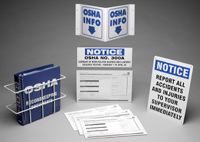 |
 |
| MSDS Topics |
Free Sites | FAQ's | Regulations | Glossary | Software | Suppliers |
| Books | Forum | Poll | Fun stuff | Quiz | Store | |
| MSDS and safety supplies | Search ALL our MSDS info | |||||
 | |||
 |
 |
 |
|
| Title: 06/20/1997 - Provisions of the Hazard Communication Standard. | |
| Record Type: Interpretation | Standard Number: 1910.1200 |
June 20, 1997
Mr. Joseph H. Thomas, Coordinator
Hazard Communication Branch
Texas Department of Public Health
1100 West 49th Street
Austin, Texas 78756-3199
Dear Mr. Thomas:
Thank you for your letter requesting clarification of provisions of the Hazard Communication Standard (HCS). Your questions had primarily to do with the definition of an article. Below, I have summarized your concerns and provided answers.

The determination of whether an item is an "article" under the HCS is made by the manufacturer. The article exemption applies to the end use of the product only--if intermediate use results in exposures, these exposures are covered by the HCS. Therefore, employees who recharge the coils or may otherwise be exposed to the refrigerant during the course of their employment are entitled to hazard information. The employer has the responsibility for conveying hazards and must address this as part of the hazard communication program.
Regarding the operation of a battery in a vehicle, the preamble to the 1987 Final Rule for HCS states that a vehicle does not have to "bear labels regarding hazardous chemicals used to operate them. This does not, however, exempt such chemicals from coverage by the rule--it simply eliminates the need to label once they are placed into the vehicle" (FR Vol. 59, No. 27, 31863).

Comply with OSHA 300 requirements with centers and forms from Safety Emporium.
The scope and application of the HCS applies anytime a "chemical" is known to be present in the workplace and requires "all employers to provide information to their employees about the hazardous chemicals to which they are exposed" (29 CFR 1910.1200(b)(1)). The HCS is not necessarily triggered by the mere presence of a chemical, the chemical must be available for exposure.
Since the employer is in a position to be aware of the chemical hazards in their workplace, it is the responsibility of the employer to evaluate the employees' potential exposures and to provide information and training as required under the HCS. If an item presents a potential exposure, then that item could be classified as a "hazardous chemical." For instance, a certain percentage of glass mercury switches are expected to break during installation in a piece of equipment. During the installation process, the switches are considered a hazardous chemical as they present a potential exposure. Hazard information is required for employees involved in the installation. Once installed, these items would be articles and thus exempted.
Sincerely,
Steve Mallinger, Acting Director
Office of Health Compliance Assistance